Gustav Stickley and
the American
Arts & Crafts Movement
by Bob Brooke
The Arts and Crafts Movement began in
Britain in the mid-19th century with John Ruskin, the foremost critic of
the factory system. He spoke out against the shoddy quality of
machine-made goods. Ruskin believed mass production enslaved workers to
machines and robbed them of the pleasure of their own labor. To correct
this, he advocated a return to the practices of the medieval trade
guilds. To Ruskin, a hand-made object had beauty because of its
irregularities.
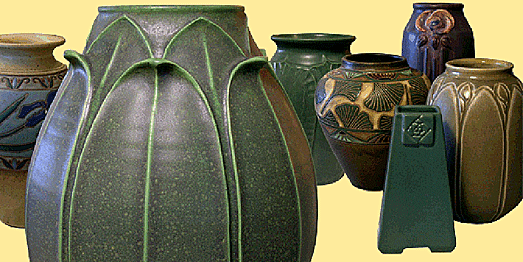
William Morris founded a firm in 1861 that put Ruskin’s ideas into
practice by producing hand-wrought furniture, textiles, wallpapers, and
stained glass. He maintained that furniture should be made of timber
rather than milled lumber.
Morris expanded the definition of art to include traditional handicrafts
and helped launch the Arts and Crafts Movement, style movement governed
by social, economic, and political reforms of the early 20th century.
The Arts and Crafts Movement
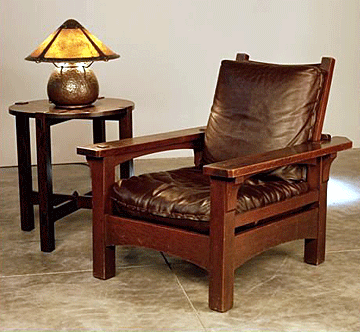 Gustav Stickley’s furniture was simple, functional, and sturdy, with a
decorative effect that depended on its revealed structure. The emphasis
on the details of joinery—tenon-and-key joints, exposed tenons, visible
dowels— celebrated the handmade nature of Stickley’s furniture while
de-emphasizing the machine processes used in its construction. Gustav Stickley’s furniture was simple, functional, and sturdy, with a
decorative effect that depended on its revealed structure. The emphasis
on the details of joinery—tenon-and-key joints, exposed tenons, visible
dowels— celebrated the handmade nature of Stickley’s furniture while
de-emphasizing the machine processes used in its construction.
His furniture gave the appearance of being handmade in the Arts and
Crafts tradition, but it actually benefited from the efficiencies of
his well-equipped factory.
In the United States, organized efforts to gather artists and Craftsman
into societies that would promote the ideals of John Ruskin, William
Morris and other European exponents of the art that is life did not
occur until then the 1890s. Gustav Stickley was a the forefront of this
movement in America.
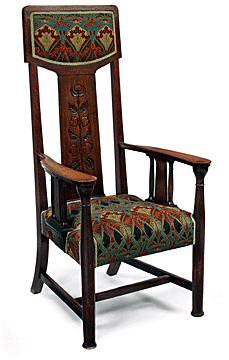 Stickley visited England and Europe during the late 19th century and
clearly benefitted from his exposure to ideas about the unification of
all the decorative arts into a new international movement called Arts
and Crafts which developed its American programs simultaneously on both
coasts during 1896 and1897. Stickley visited England and Europe during the late 19th century and
clearly benefitted from his exposure to ideas about the unification of
all the decorative arts into a new international movement called Arts
and Crafts which developed its American programs simultaneously on both
coasts during 1896 and1897.
Artist, architects and decorative artists weren’t satisfied with their
traditional roles in the new industrial society of 1900. They believe
wholeheartedly in the capacity of art to change the political and
philosophical situation of modern society. Setting the stage for the
socially engaged art of the later 20th-century.
In a major reform many Americans believe that industrialism, which had
originally promised to be a boon to American workers, had betrayed them.
The machine became the symbol of oppression. Socialism was one answer to
the problem. But the American reaction to the machine was a much more
conservative program of political progressivism. Progressives wanted
regulation rather than control, reform without revolution.
Progressive measures—the secret ballot, direct election of senators,
referendum and recall, municipal reform all things we take for granted
today–-were aimed at bringing government to the people.
Stickley has been aptly called the founder of the American Arts and
Crafts Movement in the United States, for no other figure matched his
achievements and influence in so many facets of art and design.
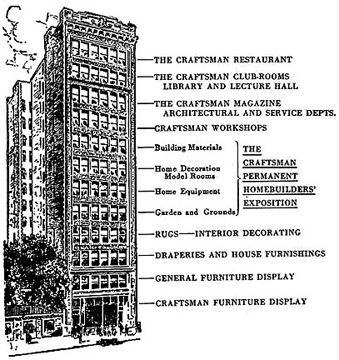 He became known as an innovator in furniture making, ceramics and
metalwork. He later moved some of his enterprises to New York City and
planned to expand his business empire, opening a department store and
publishing books and magazines under the Craftsman brand. He was a
tastemaker, a publisher, and a manufacturer. He became known as an innovator in furniture making, ceramics and
metalwork. He later moved some of his enterprises to New York City and
planned to expand his business empire, opening a department store and
publishing books and magazines under the Craftsman brand. He was a
tastemaker, a publisher, and a manufacturer.
Most of the products Stickley made were derivative of other English Arts
and Crafts prototypes. His large staff and factory designed and
fabricated hundreds of Craftsman pieces, from furniture to lighting
fixtures.
The social and political dichotomy facing America in 1900 caused
increasing tension between the 19th-century agrarian society that had
guided the founding fathers in the construction of a new nation and the
20th-century structure of urbanized, industrialized production and a
centrally controlled two-party system.
Inspired by the legacy of the 19th-century English
design reformers John Ruskin and William Morrs, the Arts and Crafts
Movement sought to elevate the notion of “good design” and to promote
the revival of craft as art.
Gustav Stickley
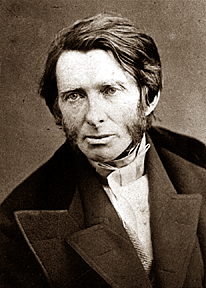 Stickley came from rural, small town America. Born in 1858 on a farm
near Osceola, Wisconsin, the eldest son of first-generation German
immigrants, Barbara & Leopold Stoeckel, who sought a better life as
pioneer settlers in the Midwest, he retained throughout his life a
belief that the farmer was the ideal American. He pursued this idea even
as he moved from the farm into the City of Syracuse where he produced
oak tables and chairs that are highly prized today.
Stickley came from rural, small town America. Born in 1858 on a farm
near Osceola, Wisconsin, the eldest son of first-generation German
immigrants, Barbara & Leopold Stoeckel, who sought a better life as
pioneer settlers in the Midwest, he retained throughout his life a
belief that the farmer was the ideal American. He pursued this idea even
as he moved from the farm into the City of Syracuse where he produced
oak tables and chairs that are highly prized today.
Hardworking farmboy experiences in Wisconsin gave him a sense of
self-determination. Yet with only a 6th-grade education, he went from a
those humble beginnings to meteoric success as a designer and
entrepreneur.
Parents separated in 1869 and by 12 had become employed as a stonemason.
Doing this, Stickley developed a sense of individuality and
self-sufficiency that would serve him in adult life.
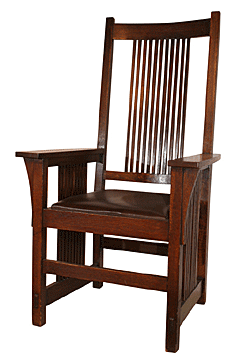 First trained as a stone mason, Stickley preferred to work in wood and
dreamed of building fine tables and chairs. He learned furniture making
at his uncle's chair factory in Lanesboro, Pennsylvania. Traveling to
Europe in 1896, he met notable Arts and Crafts designers. The following
year he returned to the United States and founded the United Crafts of
Eastwood, New York. In 1904, he founded the Craftsman Workshops. The
furniture he designed and made was mostly of native American oak. It was
of a sturdy-plain design in contrast to the highly decorated late
Victorian pieces. Joinery was exposed and upholstery was carried out in
canvas and leather (natural materials). It became known as Mission
Style. Stickley's designs were exhibited at the prestigious Grand Rapids
and Pan American furniture expositions. First trained as a stone mason, Stickley preferred to work in wood and
dreamed of building fine tables and chairs. He learned furniture making
at his uncle's chair factory in Lanesboro, Pennsylvania. Traveling to
Europe in 1896, he met notable Arts and Crafts designers. The following
year he returned to the United States and founded the United Crafts of
Eastwood, New York. In 1904, he founded the Craftsman Workshops. The
furniture he designed and made was mostly of native American oak. It was
of a sturdy-plain design in contrast to the highly decorated late
Victorian pieces. Joinery was exposed and upholstery was carried out in
canvas and leather (natural materials). It became known as Mission
Style. Stickley's designs were exhibited at the prestigious Grand Rapids
and Pan American furniture expositions.
His mother took her children to Minnesota where Stickley became
apprenticed to a cabinetmaker and began his love affair with wood.
By the time he was 18, the family had relocated to Landsboro, Pa. where
his uncle, Jacob Schlager, operated a chair factory. His uncle hired him
and he became foreman in a few years.
Stickley became successful and by 1900 operated a thriving furniture
manufacturing company in Syracuse, NY. There he met Professor Irene
Sargent who was a devotee of the Arts and Crafts Movement. Sargent
became Stickley’s mentor and encouraged him to study John Ruskin and
William Morris.
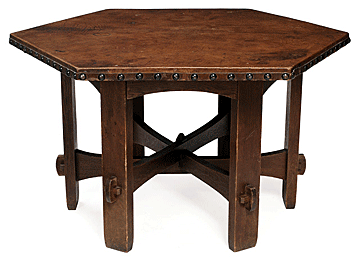 During the following decade, Stickley became a spokesman for the Arts
and Crafts Movement, publisher of The Craftsman Magazine, and head of a
firm that designed homes. During the following decade, Stickley became a spokesman for the Arts
and Crafts Movement, publisher of The Craftsman Magazine, and head of a
firm that designed homes.
Filled with ambition he moved his offices to New York City and leased a
15-story building in order to show off his furniture. There he offered
every type of object for the home. He even ran a restaurant on the top
floor of the prestigious Fifth Avenue address.
Although Gustav Stickley advocated the simple life, his own life was not
simple. He moved his business (but not his factory) to New York City,
where he spent heavily on the new Craftsman Building. The building
included “a Permanent Homebuilders’ Exhibit of every sort of building
material, with actual demonstrations of their uses” and Stickley
promised that “the amateur builder may come here to obtain expert help
on any subject.” It was an ambitious project at a time when public taste
as changing and the solid, plain Craftsman furniture was falling out of
favor. Stickley filed for bankruptcy in March 1915.
Though he lived another 26 years, Stickley's popularity had waned by the
end of the Great War.
<
Back to More Special Features
Next Article > |
